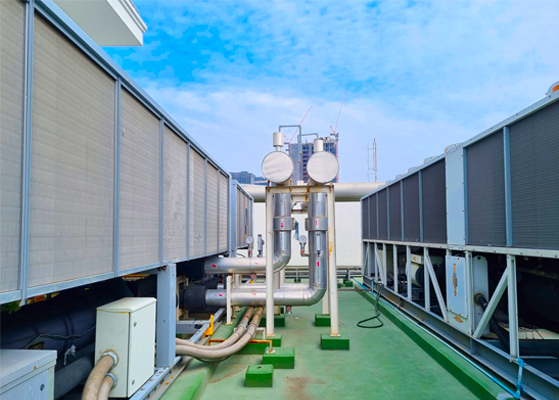Value Delivered
The Gary C. Comer Geochemistry Building (Comer Building) cooled its specialized lab equipment with the same rooftop air-cooled chillers that were used to cool the building.
While this approach provided initial cost savings during construction of the facility, the chillers were required to operate year-round and were substantially oversized for cooler months.
This capacity imbalance caused frequent short cycling of the compressors and condenser fan motors which led to numerous failures and an almost 30 percent reduction in the life of the equipment. This short cycling also caused substantially higher operating costs for the facility.
EMCOR Services New York/New Jersey Inc. installed a rooftop mounted dry cooler, which was piped in parallel with the existing chillers, to more cost effectively meet the process cooling needs during cooler months.
This solution allowed the energy-intensive chillers to remain off-line for almost a third of year, which helped extend the chillers' useful life by more than five years and helped the campus save over 200,000 kWh of electricity ($21,000 annually), and an average of $30,000 per year in maintenance costs.
The electricity savings alone will help save 141 metric tons of carbon dioxide emissions (CO2e) annually or 2,115 metric tons of Carbon over the life of the equipment. According to the Greenhouse Gas Equivalencies Calculator, this is the annual equivalent of 2,338 tree seedlings sequestering Carbon for ten years.
This project demonstrates our drive to support sustainability by implementing smart solutions to maximize energy efficiency and create a positive impact on the environment.
Client Objectives
Columbia University values energy efficiency and the environment, which includes reducing their carbon footprint. When the Comer Building’s chilled water system began showing signs of early aging, the client needed a more efficient, environmentally friendly solution.
Solutions
We worked with the client’s Facilities Engineer to:
- Design and install a new dry cooler system over an approximately six-month period
- Replace ten compressor and variable frequency drives for their existing three 300-ton air-cooled chillers
Client Background
Columbia University's Gary C. Comer Geochemistry Building houses ample lab space supporting research and development to advance climate science. This was the university's first project to earn LEED Silver certification.
